
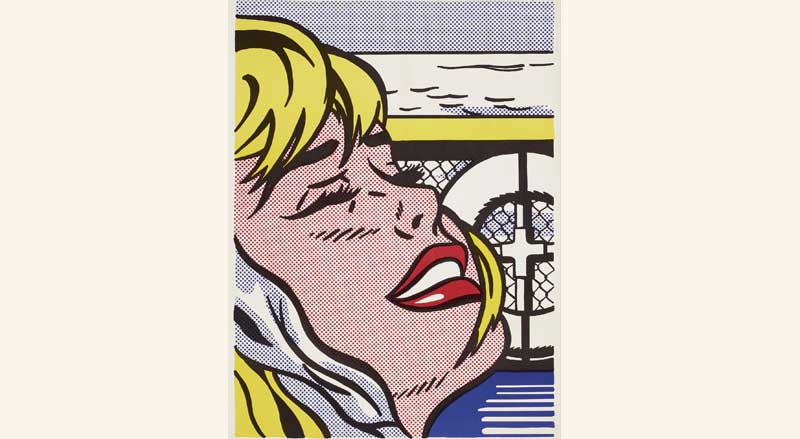
Few artists have left as bold a mark on the American Pop Art movement as Roy Lichtenstein. With his signature comic strip imagery, Benday dot technique, and cool detachment, Lichtenstein redefined the boundaries between high art and mass media. For collectors, his legacy lives on not only in major museum collections but also in a diverse range of signed and limited-edition prints—original lithographs, screen prints, woodcuts, and more—that remain highly sought after by contemporary art enthusiasts worldwide.
In this article, we explore Lichtenstein’s contribution to modern art, the various mediums he employed in his collectible works, and highlight essential suites, such as The Seven Apple Woodcuts, One Cent Life, and The Bull Profile Series.
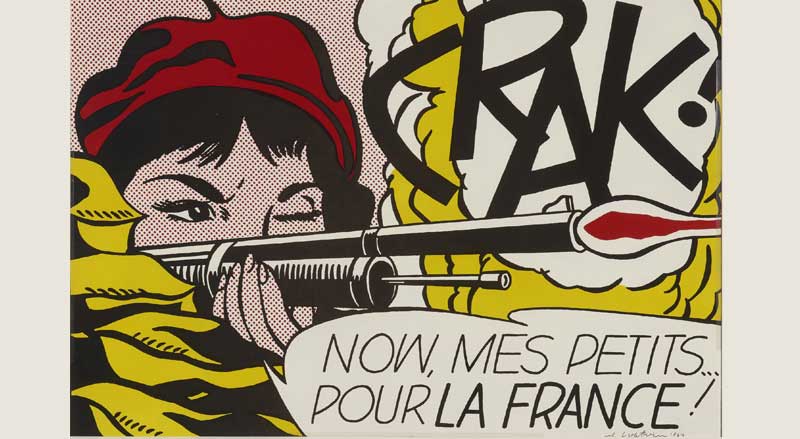
Emerging in the early 1960s, Roy Lichtenstein stood at the forefront of the Pop Art movement, alongside peers like Andy Warhol, James Rosenquist, and Claes Oldenburg. Drawing inspiration from comic books, advertising, and consumer culture, Lichtenstein’s work celebrated and critiqued American life through bold primary colors, thick black outlines, and the signature Benday dots—a print technique used in newspaper and pulp comic printing.
Unlike the emotionally expressive Abstract Expressionists who preceded him, Lichtenstein embraced irony and mechanical precision. His most famous works—Whaam!, Drowning Girl, and Look Mickey—exemplify this calculated style that walks the line between parody and homage. And while his paintings receive widespread acclaim, it is through his printmaking that many collectors have access to his unmistakable visual language.
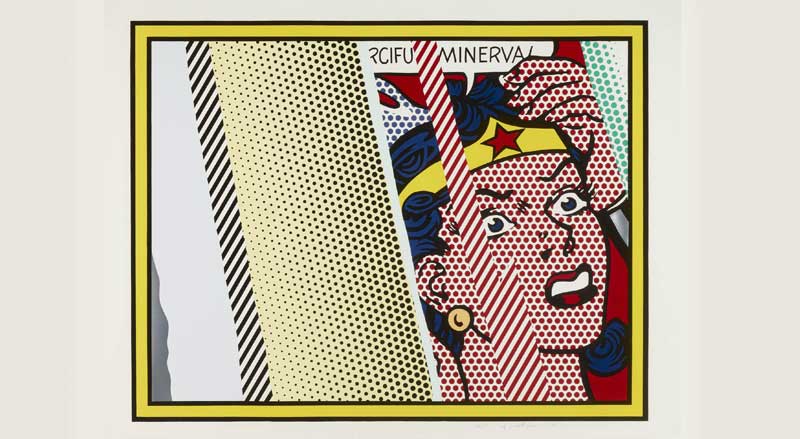
Roy Lichtenstein was not only a painter… he was a prolific and technically innovative printmaker. His limited-edition prints span a range of mediums, each offering a unique lens into his artistic practice:
Lithography allowed Lichtenstein to reproduce his meticulous line work and crisp color fields with exceptional clarity. Many of his signed lithographs were issued in limited editions of 100–300 and remain foundational to Pop Art print collections. These works often revisit iconic imagery or explore new subjects in his signature style.
Screen printing—also used by Warhol—was a perfect medium for Lichtenstein’s flat, bold compositions. With layered colors and precise outlines, his screen prints often replicate motifs from earlier paintings, showcasing his adaptability across media. The vibrant finish and exactitude of these prints make them highly desirable.
A more tactile and organic process, woodcut printing introduced subtle textures and visual contrast into Lichtenstein’s highly controlled aesthetic. The grain of the woodblock played beautifully against his flat colors and dot patterns, offering a more sculptural presence in works like The Seven Apple Woodcuts.
Lichtenstein often enhanced his prints with embossing, metallic inks, and hand-applied elements, pushing the limits of traditional printmaking and offering collectors unique, hybrid works that stand apart in both form and value.
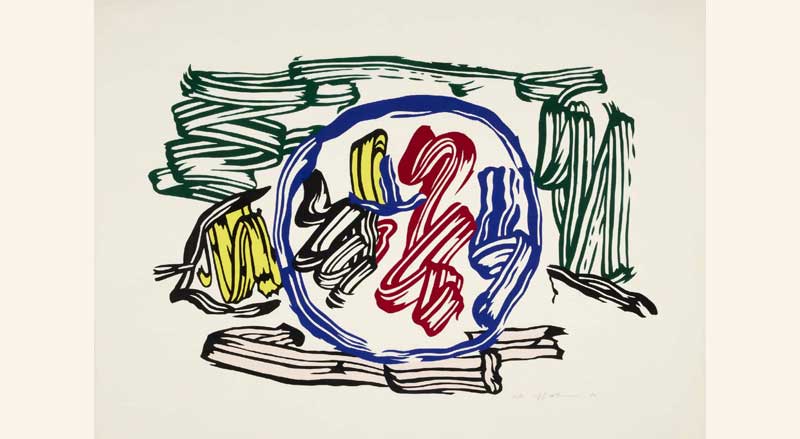
Created in 1983, The Seven Apple Woodcuts is a captivating series that reimagines the traditional still life apple with Lichtenstein’s Pop Art twist. Each print depicts an apple in bold, graphic abstraction—flattened, simplified, and rendered in primary colors, stripes, and his iconic dot patterns.
What makes this series exceptional is the contrast between the age-old technique of woodblock printing and Lichtenstein’s futuristic, industrial visual vocabulary. The use of wood grain introduces warmth and texture, while the subject matter—deceptively simple—becomes a study in how form and symbol evolve under Pop scrutiny.
Collectors prize this suite for its conceptual clarity, visual punch, and rarity, as it represents a mature period in Lichtenstein’s career and a confident embrace of mixed visual traditions.
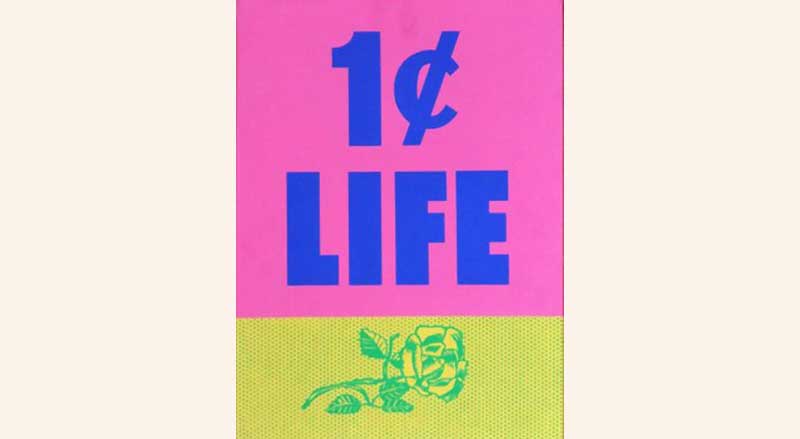
One Cent Life was a groundbreaking 1964 art book project edited by Walasse Ting and designed by Sam Francis. This portfolio brought together original lithographs by 28 leading contemporary artists of the time—including Roy Lichtenstein, Andy Warhol, Joan Mitchell, Jim Dine, and Robert Rauschenberg—paired with Ting’s vibrant poetry.
Lichtenstein’s contribution to One Cent Life stands out as a masterclass in Pop simplicity and comic-inspired visual structure. These works capture the artistic energy of the 1960s and situate Lichtenstein within a broader international network of modern art innovators.
For collectors, prints from One Cent Life offer both historical relevance and substantial investment value, as they represent a pivotal moment when Pop Art was gaining global recognition.

A conceptual gem in Lichtenstein’s oeuvre, the Bull Profile Series (1973) comprises six screen prints that gradually reduce the image of a bull from a semi-realistic to an abstract geometric form. Inspired by Picasso’s 1940s bull lithographs, Lichtenstein offers his take on visual deconstruction.
Beginning with a relatively straightforward depiction of a bull, each successive print strips away detail, transitioning the subject into bold geometric forms. The final image—reduced to a few angular shapes—still suggests the essence of the animal.
Collectors love this suite for its wit, clarity, and commentary on abstraction. It’s a prime example of Lichtenstein’s ability to combine artistic tradition with modern minimalism, all while maintaining his distinct Pop Art lens. Limited in number and conceptually rich, the Bull Profile Series remains a top-tier collectible in the Lichtenstein catalog.
Roy Lichtenstein’s art is instantly recognizable yet intellectually layered. His prints offer collectors a chance to own museum-quality works that span decades of stylistic innovation. Whether you’re drawn to his comic book heroines, architectural abstractions, or experimental still lifes, his limited edition works offer timeless visual appeal and strong investment potential.
At Dane Fine Art, we are proud to offer an extensive collection of original, authenticated Lichtenstein prints, including pieces from the Seven Apple Woodcuts, One Cent Life, and Bull Profile series. Each piece is carefully curated to meet the highest standards of quality and provenance.
Ready to begin or expand your Lichtenstein collection? Please browse our current inventory of signed lithographs, woodcuts, and screen prints here or reach out to our knowledgeable team for personalized guidance. Let us help you acquire a piece of Pop Art history.
Showroom
2320 Haverford Road
Ardmore PA 19003
Showroom
2320 Haverford Road
Ardmore PA 19003
Subscribe to receive our newsletter and notifications about new arrivals.